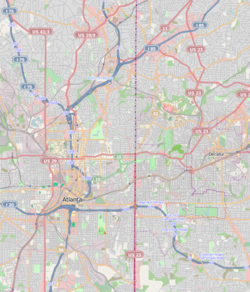Lakewood Heights | |
|---|---|
 location of Lakewood Heights in southeast Atlanta | |
| Country | United States |
| State | Georgia |
| County | Fulton County |
| City | City of Atlanta |
| NPU | Y |
| Population (2008) [1] | |
• Total | 2,750 |
Lakewood Heights Historic District | |
| Location | jct. of Jonesboro Rd. and Lakewood Ave., Atlanta, Georgia |
|---|---|
| Area | 219 acres (89 ha) |
| Built | 1895 |
| Architect | William Augustus Edwards, William J. Sayward |
| Architectural style | Colonial Revival |
| NRHP reference No. | 02000712 [2] |
| Added to NRHP | July 5, 2002 |
Lakewood Heights is a historic neighborhood established in the late 19th century. [3] It experienced significant growth in the 1920s and 1930s as both an industrial and residential area. Originally, it was a predominantly Jewish working-class community but gradually changed to a predominately African American working-class community. However, as of the 2010s, the neighborhood is again undergoing notable changes. Gentrification has increased diversity and rising demand have positively transformed the area, driven by new developments along the nearby Atlanta Beltline and Downtown Atlanta. For many years before this revitalization, Lakewood Heights struggled with high vacancy rates and low home sales. [4] It is bounded by:
Contents
- History
- Factors leading to development
- Private enterprise and model homes
- Assembly plant to media productions
- Parks
- Gallery
- See also
- References
- External links
- the Betmar LaVilla, the Villages at Carver, and South Atlanta neighborhoods on the north,
- the Chosewood Park neighborhood on the northeast,
- the Norwood Manor neighborhood on the southeast,
- the Polar Rock, Swallow Circle/Baywood and Lakewood neighborhoods on the south
- the Downtown Connector on the west, across which lie the Sylvan Hills and Capitol View Homes neighborhoods
Lakewood Heights contains the Lakewood Heights Historic District, listed on the National Register of Historic Places.












